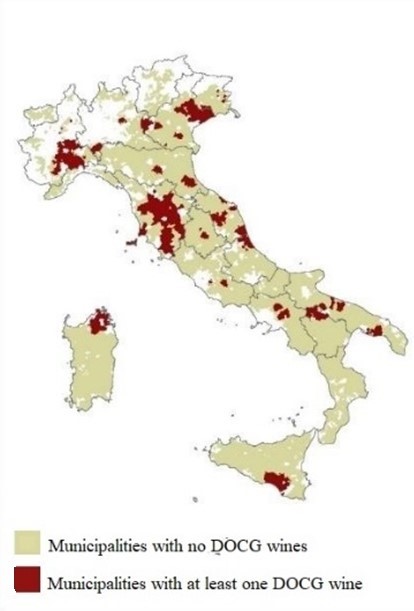


 By Riccardo Crescenzi (LSE), Fabrizio De Filippis (Roma Tre University), Mara Giua (Roma Tre University) and Cristina Vaquero-Piñeiro (Roma Tre University)
By Riccardo Crescenzi (LSE), Fabrizio De Filippis (Roma Tre University), Mara Giua (Roma Tre University) and Cristina Vaquero-Piñeiro (Roma Tre University)
Geographical Indications play a propulsive role for local development in rural areas with very limited public expenditure, whereby the locality’s features, history and traditions are part of the product itself. They provide protection against reproduction elsewhere, facilitate an upward effect on pricing and quality reputation, and improve demographic trends and sectoral re-composition.
Geographical Indications and Local Development
Geographical Indications (GIs) granted by the European Union (EU) to recognise and certify products associated with a specific region-of-origin and with traditional production techniques can offer tangible opportunities for local economic development in rural areas. By signalling to global markets and protecting unique agri-food products from unfair competition, GIs offer rural economies the opportunity to link up with global markets while retaining their uniqueness. The locality with its features, history and traditions becomes part of the product itself, making it impossible to reproduce elsewhere.
The most renowned and appreciated agri-food product that has benefitted from Protected Designation of Origin (PDO) or Protected Geographical Indications (PGI) is wine. Riccardo Crescenzi, Fabrizio De Filippis, Mara Giua and Cristina Vaquero Piñeiro study the role that GI-protected wine can play in the development of those rural areas where it is produced (Crescenzi et al, 2021). They find that rural areas whose wine production is protected by a GI experience lower population decline and a reorganisation of the economy towards higher value-added activities (non-farming vs farming sectors), vis-à-vis other rural areas with similar characteristics but which are unable to rely on the protection and recognition offered by GIs. In other words, GIs play a propulsive role for local development in rural areas with very limited public expenditure.
DOCG Wines
This evidence comes from the case of Italy, one of the countries with the highest number of GIs, by focusing on GI wines, for which Italy has a prominent role worldwide. In particular, they study the impact of DOCG (Denominazione di Origine Controllata e Garantita) wines, the top-level category of PDO wines in the country, on the population trends and the employment variation in farm vs non-farm sectors. In order to identify causal impact they use econometric models to compare municipalities with DOCG to a group of counterfactual municipalities that are similar in every respect, but without an acknowledged DOCG certification. This makes it possible to control for any time-invariant difference between the treated (DOCG) and the control municipalities as well as for any time-variant aspect varying similarly across them, isolating the impact of GIs from any other factor that might affect the outcomes of interest.

Institutional Strength
Another relevant insight of the study is the qualification of participation to the GI scheme as a signal of strong local institutions. In order to be certified in the GI scheme, the product needs to pass very demanding tests regarding its uniqueness and linkage with the region-of-origin. This is approved if producers and local actors together obtain this result, reflecting a very consolidated network of collaboration rooted in traditions. Due to these characteristics the GI scheme can be regarded as a policy tool that facilitates and enables the translation of local informal institutions into formal space-sensitive regulations that are globally recognised.
The study demonstrates that the existence of a formal and globally-recognised scheme, that certifies the existence of distinct linkages to the product-region of origin, makes areas with strong local institutions capable of retaining and leveraging models of embedded productions to become competitive in world markets. This signalling tool can also generate an upward effect on product pricing and quality reputation. These effects transform into revenues for producers and for a large number of local players. They also eventually improve the attractiveness of the areas for producers and all other economic actors involved in the products’ chain. This leads to positive effects in terms of demographic trends and sectoral re-composition, identified as traditional indicators of local development in rural areas.
Conclusion
With limited budget resources the EU can offer its rural areas the opportunity to become part of and benefit from economic globalisation precisely by being (and remaining) local. GIs establish new global-local linkages. The product-region of origin is exploited for the differentiation of the product that becomes unique and distinct from the majority of other agri-food goods (that, on the contrary, are produced in a context of increasing standardisation and homogeneity).
Investing in local embedded production may offer unique opportunities to foster sustainable socio-economic development in rural areas. Relevant policy results can be achieved by tapping into potential territory-specific economic features and supporting community-led expertise. Traditional capabilities and practices should be preserved, while building new institutional bridges towards global opportunities.
****
This post represents the views of the author and not those of the GILD blog, nor the LSE.
This article is based on (2021) ‘Geographical Indications and local development: the strength of territorial embeddedness’, Regional Studies
Riccardo Crescenzi is a Professor in the Department of Geography and Environment, the London School of Economics
Fabrizio De Filippis is a Professor in the Department of Economics, Roma Tre University
Mara Giua is an Assistant Professor in the Department of Economics, Roma Tre University
Cristina Vaquero-Piñeiro is a Research Fellow in the Department of Economics, Roma Tre University






